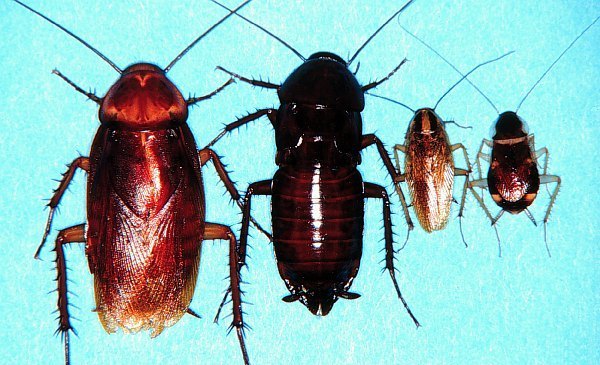Oriental and wood cockroaches are two species of cockroach that are able to survive Nebraska's harsh winters. Both species are active during the late spring of the year. It is important to be able to distinguish these species because the oriental cockroach can live and breed indoors, but the wood roach rarely breeds indoors. Wood roaches truly are accidental invaders and have no real pest status.
Wood Cockroaches
Wood roaches prefer to live outdoors, in rotted logs, tree stumps, hollow trees, and under the loose bark of dead trees. They also may live under cedar-shake shingles and siding, in rain gutters, and between brick pavers and retaining walls. Wood roaches can be brought into homes with firewood. During May and early June, mate-seeking male wood roaches become active. They are good fliers and are attracted to lights. They enter the house at night around windows, doors, and other openings. Once indoors, wood roaches usually die within a few days of their accidental invasion into the house from desiccation. The female wood roach has short wings and cannot fly and rarely - if ever - comes indoors. This means infestations cannot get started inside. Because the wood cockroach does not breed indoors, it is an annoyance, but these roaches do not harm the house structure, furnishings, or occupants.How to Identify Wood Cockroaches
Wood roaches have white stripes present on the edges of the thorax and front portion of the wings. The wings of the males extend slightly beyond the tip of the abdomen.How to keep them from invading your Home
They are an accidental invader but exclusion techniques are most helpful. Doors and windows should be tight-fitting and cracks, gaps and other possible entry points should be sealed. Reduce lighting around the house or use yellow bulbs which are less attractive to night-flying insects.Oriental Cockroaches
The oriental cockroach is the only cockroach in Nebraska which survives outdoors and also can live and breed indoors. Often called "waterbugs," they live in dark, moist places, like sewers, drains, damp basements, and crawlspaces. Outdoors, they are found in mulched areas and under leaf litter. They also live in the spaces between block retaining walls, and other areas that stay moist and cool. Oriental cockroaches have a seasonal developmental cycle. The number of adults peaks in late spring and early summer. Outdoors, these cockroaches suffer in the heat of the summer and may enter houses during hot, dry periods to find cooler places to live.How to Identify Oriental Cockroaches
Oriental cockroaches are about one inch long and dark brown to black. Their bodies are shiny and seem to be greasy. Females appear to be wingless, but, if examined carefully, you can see small wing pads just behind the head. Males have short wings covering about three-quarters of the abdomen and are unable to fly. This cockroach has a heavier body than other cockroach species and move more slowly.How to keep them from invading your Home
If oriental cockroaches are found indoors, the first step to reducing their numbers is to locate and eliminate moisture, food, and harborage. Especially focus on water problems because oriental cockroaches have a very high moisture requirement. Be sure to investigate possible water sources, such as leaky plumbing, toilets, and shower stalls which could be providing moisture. Reduce humidity by running a dehumidifier to reduce the moisture in the air. Prevent oriental cockroaches from going down drains by using screens. Make sure you do not leave pet food or water dishes out overnight. Place sticky traps in locations where you have seen roaches. Chem-Tech Pest Solutions can assist you with the best type of baits needed to remove these pests from your home. Contact us today.
